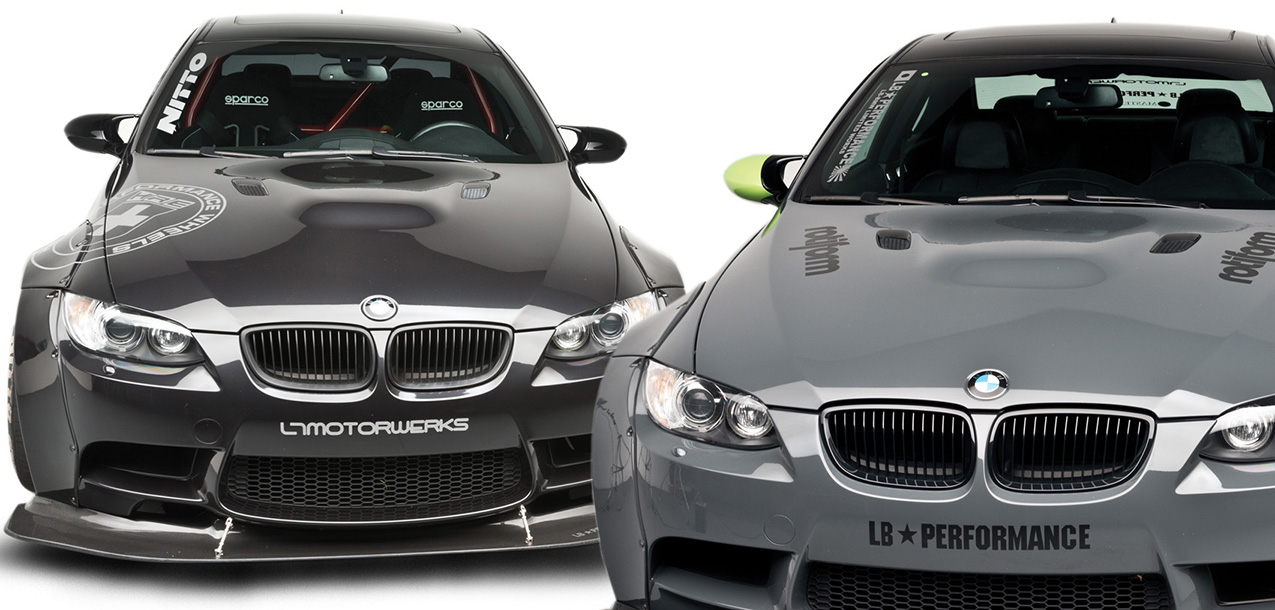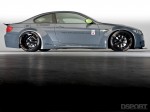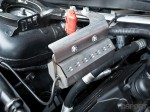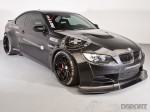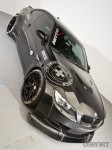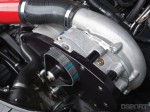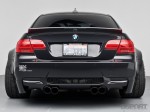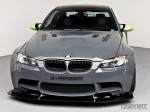Kato’s Gray Machine
 Kato’s BMW began as a completely stock white M3. In addition to the LWLBP widebody and Lamborghini Grigio Telesto paint, Kato added many other supporting modifications. Kato chose KW Suspension’s Clubsport 2-way coilovers to keep his M3 close to the ground. To help the vehicle stay firmly planted, a set of 19×10.5-, 19×12-inch Rotiform SNAs wrapped in 275/35R19 and 305/30R19 Nitto Invos filled the fenders. The aero kit and wheel combination gives the M3 a very aggressive stance. To match the bold aesthetic impact of the vehicle, Kato added an exotic exhaust note by mating a Mastermind X-Pipe to an Arqray stainless-steel exhaust.
Kato’s BMW began as a completely stock white M3. In addition to the LWLBP widebody and Lamborghini Grigio Telesto paint, Kato added many other supporting modifications. Kato chose KW Suspension’s Clubsport 2-way coilovers to keep his M3 close to the ground. To help the vehicle stay firmly planted, a set of 19×10.5-, 19×12-inch Rotiform SNAs wrapped in 275/35R19 and 305/30R19 Nitto Invos filled the fenders. The aero kit and wheel combination gives the M3 a very aggressive stance. To match the bold aesthetic impact of the vehicle, Kato added an exotic exhaust note by mating a Mastermind X-Pipe to an Arqray stainless-steel exhaust.
Pena’s Black Steed
 When approached with the opportunity to be one of the first LWLBP M3s in America, Bernardo Peña couldn’t resist. Like Kato’s vehicle, Peña’s M3 received the LWLBP widebody. To help the fenders sit precisely over the wheels, Peña went with a set of KW Suspension Variant 3 coilovers. From there, the differences between the vehicles become apparent. Unlike Kato, Peña decided to build his M3 more in line with a racecar. This meant bucket seats, a roll bar, and a big-brake kit. Inside, Sparco Pro 2000 racing seats give the cockpit a more performance-oriented feel. To complement the bucket seats, Peña chose Sparco six-point harnesses to replace the factory safety restraint system. An Autopower roll bar provides the mounting location for the racing harnesses and adds stiffness to the chassis. A set of Brembo binders comprised of monoblock six-piston front, four-piston rear calipers clamp huge cross-drilled 380mm rotors. These Brembo brakes help bring 19-inch HRE S101s wrapped in 275/35R19 and 305/30R19 Nitto Invos to a halt.
When approached with the opportunity to be one of the first LWLBP M3s in America, Bernardo Peña couldn’t resist. Like Kato’s vehicle, Peña’s M3 received the LWLBP widebody. To help the fenders sit precisely over the wheels, Peña went with a set of KW Suspension Variant 3 coilovers. From there, the differences between the vehicles become apparent. Unlike Kato, Peña decided to build his M3 more in line with a racecar. This meant bucket seats, a roll bar, and a big-brake kit. Inside, Sparco Pro 2000 racing seats give the cockpit a more performance-oriented feel. To complement the bucket seats, Peña chose Sparco six-point harnesses to replace the factory safety restraint system. An Autopower roll bar provides the mounting location for the racing harnesses and adds stiffness to the chassis. A set of Brembo binders comprised of monoblock six-piston front, four-piston rear calipers clamp huge cross-drilled 380mm rotors. These Brembo brakes help bring 19-inch HRE S101s wrapped in 275/35R19 and 305/30R19 Nitto Invos to a halt.


Better With Boost

 With the aesthetics of a racecar, the M3s yearned for more power to back up their looks. LWLBP turned to ESS Tuning, a Norwegian-based BMW tuning shop, to add boost to its widebody BMWs. ESS Tuning’s VT1-550 supercharger system consists of a Vortech V3Si supercharger, street-spec bypass assembly, uni-belt drive system, Bosch Motorsport fuel injectors, MSS60 ECU software, CNC hard-anodized brackets and a cast aluminum ESS intake manifold. The supercharger draws air through a K&N high-flow air filter. The self-contained supercharger, capable of producing airflow to support up to 775 horsepower is driven by a uni-belt drive system with OEM quality rollers. The compressed air rushes out of the blower and into the cast aluminum ESS intake manifold. The manifold features integrated velocity stacks. Once the air charge enters the combustion chamber, the high-flow Bosch Motorsport fuel injectors disperse a higher volume of fuel to mix with the additional air. To handle the optimization of fuel delivery, ESS utilizes its MSS60 ECU software. This software allows proper fuel and ignition control, optimization of the VANOS variable valve timing system and removal of the top-speed governor. To achieve maximum power and reliability, the BMWs took a trip to European Auto Source for final tuning on a Dynojet 224xLC Dynamometer.
With the aesthetics of a racecar, the M3s yearned for more power to back up their looks. LWLBP turned to ESS Tuning, a Norwegian-based BMW tuning shop, to add boost to its widebody BMWs. ESS Tuning’s VT1-550 supercharger system consists of a Vortech V3Si supercharger, street-spec bypass assembly, uni-belt drive system, Bosch Motorsport fuel injectors, MSS60 ECU software, CNC hard-anodized brackets and a cast aluminum ESS intake manifold. The supercharger draws air through a K&N high-flow air filter. The self-contained supercharger, capable of producing airflow to support up to 775 horsepower is driven by a uni-belt drive system with OEM quality rollers. The compressed air rushes out of the blower and into the cast aluminum ESS intake manifold. The manifold features integrated velocity stacks. Once the air charge enters the combustion chamber, the high-flow Bosch Motorsport fuel injectors disperse a higher volume of fuel to mix with the additional air. To handle the optimization of fuel delivery, ESS utilizes its MSS60 ECU software. This software allows proper fuel and ignition control, optimization of the VANOS variable valve timing system and removal of the top-speed governor. To achieve maximum power and reliability, the BMWs took a trip to European Auto Source for final tuning on a Dynojet 224xLC Dynamometer.
Similar, But Not Quite The Same
[pullquote]THESE BMW’S REPRESENT JAPANESE ROUGH STYLE AERODYNAMICS COUPLED WITH EUROPEAN ENGINE AND SUSPENSION TUNING[/pullquote]Built together in just thirty hours, the M3s exemplify the hard work of LT Motorwerks. To meet the deadline for MFEST 2013, LT Motorwerks had no choice but to complete the BMWs from start to finish in little over a day. Despite the limited time, LT Motorwerks took no shortcuts and these two M3s demonstrate what can be done with the proper combination of aspiration and determination. The two M3s, although similar, reflect each owner’s personality. The LWLBP aero kits alone make these M3s unique, a feat tough to accomplish in a world littered with counterfeits and replicas. Not only do these BMWs represent Japanese “Rough Style” aerodynamics coupled with European engine and suspension tuning, but they also demonstrate how two traditionally distinct automotive cultures can combine to produce a phenomenal machine.


